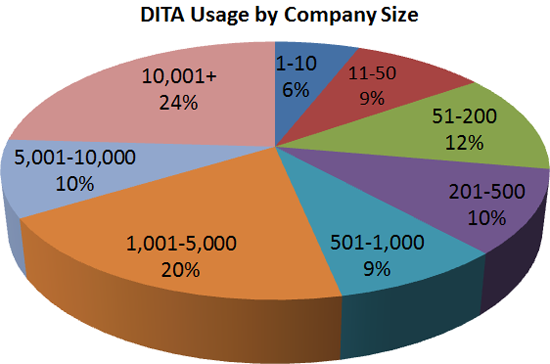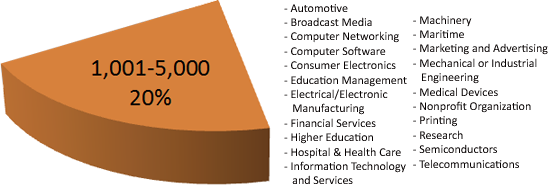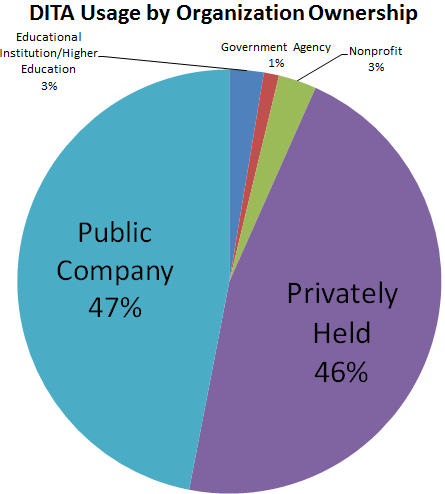For DITA XML, does “one size fit all”? The answer is: “yes”.
When doing my recent revamp of the Companies using DITA listing, the information available on LinkedIn not only included the industry category that a company belonged to, but all the size of the company in terms of the number of people it employed. My expectation from my experience as an industry consultant was that it would primarily be the larger companies that are using DITA, but that turned out not to be the case, as the following graph makes clear:

Now all of this depends on what you call a “small company” and what you call a “large company”. While the distinction is somewhat arbitrary, if you use the yardstick that U.S. Small Business Administration uses, on average the cutoff point between a small and a large industry lies somewhere in the 500-1,000 people range (this depends very much on industry, but broadly applies to the types of firms being looked at here). If we take 500 employees as the cutoff point between large and small, then yes, a majority of “large” firms are using DITA. But at 63% this is not exactly overwhelming, and to me suggests strongly that DITA is a “one size fits all” solution.
A Slice of Diversity
While seeking other patterns in the data, I found that Computer Software and Information Technology and Services are well represented throughout the slices, and that some industry types tend to the small side (Writing and Editing, Consultancy), and others to the large (Biotechnology, Financial Services, Oil & Energy) for the most part the spread of industry sectors using DITA was diverse.
As an example, here’s a breakdown of all of the industry sectors represented in the second-largest piece of the pie, the 20% of companies using DITA that have between 1,001-5,000 employees:

While Computer Software and Information Technology & Service firms dominate this slice in terms of the sheer number of firms (which is the same for most of the slices of this pie) it is interesting to see the diverse number of industry types that are represented.
Private vs. Public?
One other piece of information that LinkedIn provided about most of the companies it lists is whether they are publicly owned, privately held or belongs to some other classification. I didn’t know what to expect here, as I doubted that whether a firm was publicly- or privately-owned would make a difference when it came to DITA adoption. I was right:

As you can see it is basically an even split. What I find interesting in this particular chart is the small but not insignificant portions belonging to Government, Nonprofit and Educational Institutions. To my mind these are clearly areas for future growth in DITA adoption.

Extremely interesting! I need to check this out at my locality. I am thinking of taking up Industry consultancy.
Any guidance or help you could provide would be greatly appreciated.
regards.
I want to emphasize that this information is informally-derived and that it is not as rigorous as I would hope a professional report on this subject would be. I stand by my data, but this information is “shallow”, as I cannot tell you how pervasive DITA usage is in these firms, just that at least one documentation team in that firm is (or was). I’d be happy to do that level of research, but someone would have to pay me to do it. 😉
Very interesting, Keith!
I’m wondering, though, if there is any correlation between the size of the company and the number of actual DITA users there. From my experience, I can tell that if a large company uses DITA, it doesn’t necessarily mean a significant number of employees who use DITA.
For example, one of our recent customers in DITAToo is an international company with over 20,000 employees all over the world. However, there are only 5 technical writers who are using DITA. At the same time, we were a part of DITA implementation in another large company (17,000 employees or so), and the number of DITA users was 60 (which is also not too big comparing to the total number of employees).
But it would be interesting to see if there is any kind of correlation between the size of the company and number of DITA users.
Much as I said in my response above to Viju, this information is informal and somewhat “shallow”. The evidence I am able to gather tells me that a doc team at a company is using DITA, but scant information as to how pervasive DITA is within the organization. In large companies there are often more than one doc team, and it may be that there is only a single division within that firm that is using DITA.
Having said that, from my own experience and from anecdotal evidence once DITA is successfully established within an organization it often spreads for use elsewhere within the organization.
I stand by my the information that I have here–and I always welcome changes/corrections–but it would take a professional study that could dig a bit deeper than I am able to with the time and resources I have at hand to be able get a definitive answer to your question.